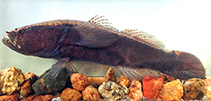| Diagnosis: |
Dorsal spines (total): 7-7; Dorsal soft rays (total): 8-9; Anal spines: 1-1; Anal soft rays: 8-9. Diagnosis: Eleotris valadei is distinguished by second, third and fourth suborbital free neuromast rows on cheek extending ventrally past horizontal row 'd' ('2.3.4' pattern), row 'os' connected with row 'oi' at ventro-posterior margin of operculum ('closed' pattern); 18 pectoral fin rays; 59-64 scales in lateral series and 27-30 scales in transverse forward series (Ref. 123271). Eleotris valadei differs from the other species of the Indian Ocean with a '2.3.4' pattern by several characters; it differs from E. soaresi in having more scales in lateral series, 59-64 vs. 50-56, more scales in transverse forward series, 27-30 vs. 22-24, in predorsal series, 45-50 vs. 39-43, and in zigzag series, 13-15 vs. 12-13; it differs from E. diamsoi in having 18 pectoral fin rays vs. 16, more scales in transverse forward series, 27-30 vs. 17-23, in predorsal series, 45-50 vs. 36-38, and a higher body depth at dorsal fin origin, 19-24 vs. 15-18 (Ref. 123271). Description: The body is elongated; the body depth at anus is 19-24% of standard length and the caudal peduncle depth is 13-17% of standard length; predorsal length 42-49% of standard length and preanal length 66-70% of standard length (Ref. 123271). The hea,d 33-39% of standard length, is broad and depressed, the snout is pointed; eyes high on head; the mouth is large, as the jaw length is 11-15% of standard length, and oblique, the posterior margin of upper jaw reaches the vertical through the two thirds of the eye; upper and lower jaws with multiple rows of small inwardly curved teeth; larger on outer row on upper jaw and larger on inner jaw on lower jaw; a few small caniniform teeth in posterior position (Ref. 123271). Dorsal fins VI-I,8-9; first dorsal fin spine separate from and slightly higher than second dorsal fin spine; spines not elongated; anal fin I,8-9 and directly opposite to second dorsal fin; pelvic fins separate, I,5; pectoral fins 18; caudal fin pointed with 15 branched rays (Ref. 123271). Cycloid scales on top of head, nape, cheek, operculum, pectoral fin base, prepelvic region, and abdomen; ctenoid scales covering flanks; no lateral line canals; scales in lateral series 59-64, in predorsal series 45-50; scales in transverse back series 17-21, in transverse forward series 27-30 and 13-15 in zigzag series (Ref. 123271). A downward pointing spine at the posterior margin of the preoperculum is covered with skin; gill opening is moderately broad, extending to below the preoperculum; tubular anterior nares overhanging upper lip, posterior nares open pits (Ref. 123271). Adults with five transverse suborbital free neuromast rows of which second, third and fourth suborbital free neuromast rows on cheek extending ventrally past horizontal row 'd' (2.3.4' pattern); row 'os' connected with row 'oi' at ventro-posterior margin of operculum ('closed' pattern) (Ref. 123271). Urogenital papilla in females rounded, elongated and tapered in males (Ref. 123271). Colouration: Colour in life of male and female is similar: top of head, top of the eye and back beige with brown freckles; lateral part of head and body dark brown; abdomen and gular region dark brown; lips with dark brown with evenly spaced yellow spots; first dorsal fin with 2-3 large horizontal dark bands alternating with 2 white bands; rays with yellow to orange spotted wavy rows alternating with black; second dorsal, anal and pelvic fins with yallow to orange spotted wavy rows alternating with black; caudal fin dark brown, with in the superior part, at anterior position, a small beige and black striped area; pectoral fins translucent grey, pectoral base dark brown (Ref. 123271). Colour in preservation of male and female similar: head and body dark brown; abdomen and gular region dark brown; first dorsal fin with 2-3 large horizontal dark bands alternating with 2 greyish bands; rays with greyish spots alternating with black wavy spotted rows; second dorsal, anal and pelvic fins with greyish spots alternating with black wavy spotted rows; caudal fin dark brown, with in the superior part, at anterior position, a small beige and black striped area; pectoral fins greyish, pectoral base dark brown (Ref. 123271). |
